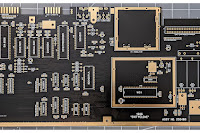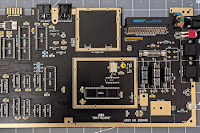And so my dabbling in alternative photography takes a turn for the truly historic, going back to one of the first methods of permanently fixing light onto paper. Called Salt Print Photography, there is somewhat more to this than simply salt and paper, but once the materials have been obtained the principal is extremely easy, though the execution takes a bit more trial and error. This process was invented by William Henry Fox Talbot in the 1830's so it goes back to the very beginnings of photography.
 |
| Photogenic drawing of a Fern leaf |
The leaf print (called a photogenic drawing) above is my first success with salt paper printing. I wanted to try 3 methods. Firstly, a leaf print to ensure my chemistry was working; secondly a contact print with a negative to see if any fine detail can be obtained with my materials, and finally, using the salt paper in a camera (my Eastman Kodak Folding Brownie) to see if it's possible to create a negative.
Requirements
- Good quality white writing or watercolour paper
- Salt (pure sea salt)
- Silver Nitrate
- Sodium Thiosulphate
- Citric Acid
- Syringe (that you will not use for anything else)
- 2 x glass beakers (that you will not use for anything else)
- Glass rod or a brush (that you will not use for anything else)
Process
 |
| One litre of water |
 |
| Twenty grams of salt |
Mix a 2% salt solution (20g of salt to 1 litre of water). Soak the paper in the solution for two minutes then leave to dry.
Under safe-light conditions, and wearing gloves, mix a 25% sensitising solution (5 grams of silver nitrate to 20 millilitres of water). Do NOT get this onto your skin or into your eyes - I cannot stress this enough. This should be mixed in a glass beaker that you should only ever use for mixing silver nitrate.
In a separate beaker mix a 10% citric acid solution (2 grams citric acid to 20 millilitres of water). When the acid has completely dissolved, pour into the silver nitrate solution. This helps to preserve the sensitising solution and stops it from forming unwanted precipitates (i.e. going cloudy). We now have 40 millilitres of sensitising solution and because we have diluted our silver nitrate, this gives us the 12% (approx) silver nitrate solution we need to continue.
We then coat one side of the pre-salted paper evenly with this sensitising solution. One method is to use a syringe to dispense a line of liquid across the top of the paper and then a glass rod to disperse, repeating in different directions. A sponge or brush can also be used but this is likely to result in a less even coat. I use a brush and, as you will see, there are imperfections aplenty.
So, what's happening here is that the silver nitrate solution reacts with the salt in the paper to form silver chloride. Silver chloride, in turn, reacts with sunlight and turns to metallic silver which appears black. This process is called photolysis. This is a decomposition reaction where exposure to light forces an electron from the chlorine ions in the silver chloride which is then captured by the silver ions, meaning the silver chloride turns to both silver metal and chlorine and it's the silver we see turning dark and that's how we get a black and white photograph. Silver nitrate and silver chloride are messy and poisonous chemicals so it is absolutely imperative you do not use these tools for other chemistry. And I will say it again, do NOT get this stuff on your skin. It will turn black in sunlight, and it will not wash off for days. You have been warned.
After a few false starts (problems with the paper I was using) I eventually obtained the image of the fern leaf you can see above. I simply placed the leaf onto the treated paper and set that in a clip frame. I took this into the garden. Surprise, surprise, it was a very cloudy day so I just left it there for an hour. In that time the exposed paper turned a very dark brown. Where the leaf prevented light from reaching the silver chloride, the paper remained white. And as simply as that, the image was created. Had it been a bright day, 10 minutes exposure would probably have been enough.
The next step is to fix the image so that it doesn't continue to react to light.
Firstly, rinse the image for 5 minutes to remove excess silver, you will see a cloudy substance running off. To fix the image, mix a 5% Sodium Thiosulphate solution (25 grams Sodium Thiosulphate to 500 millilitres of water). Soak the image in this solution for 5 minutes, then rinse again in water for 5 minutes. The negative will lighten significantly during this process.
 |
| Paper soaking in 2% salt solution |
Under safe-light conditions, and wearing gloves, mix a 25% sensitising solution (5 grams of silver nitrate to 20 millilitres of water). Do NOT get this onto your skin or into your eyes - I cannot stress this enough. This should be mixed in a glass beaker that you should only ever use for mixing silver nitrate.
In a separate beaker mix a 10% citric acid solution (2 grams citric acid to 20 millilitres of water). When the acid has completely dissolved, pour into the silver nitrate solution. This helps to preserve the sensitising solution and stops it from forming unwanted precipitates (i.e. going cloudy). We now have 40 millilitres of sensitising solution and because we have diluted our silver nitrate, this gives us the 12% (approx) silver nitrate solution we need to continue.
We then coat one side of the pre-salted paper evenly with this sensitising solution. One method is to use a syringe to dispense a line of liquid across the top of the paper and then a glass rod to disperse, repeating in different directions. A sponge or brush can also be used but this is likely to result in a less even coat. I use a brush and, as you will see, there are imperfections aplenty.
So, what's happening here is that the silver nitrate solution reacts with the salt in the paper to form silver chloride. Silver chloride, in turn, reacts with sunlight and turns to metallic silver which appears black. This process is called photolysis. This is a decomposition reaction where exposure to light forces an electron from the chlorine ions in the silver chloride which is then captured by the silver ions, meaning the silver chloride turns to both silver metal and chlorine and it's the silver we see turning dark and that's how we get a black and white photograph. Silver nitrate and silver chloride are messy and poisonous chemicals so it is absolutely imperative you do not use these tools for other chemistry. And I will say it again, do NOT get this stuff on your skin. It will turn black in sunlight, and it will not wash off for days. You have been warned.
After a few false starts (problems with the paper I was using) I eventually obtained the image of the fern leaf you can see above. I simply placed the leaf onto the treated paper and set that in a clip frame. I took this into the garden. Surprise, surprise, it was a very cloudy day so I just left it there for an hour. In that time the exposed paper turned a very dark brown. Where the leaf prevented light from reaching the silver chloride, the paper remained white. And as simply as that, the image was created. Had it been a bright day, 10 minutes exposure would probably have been enough.
The next step is to fix the image so that it doesn't continue to react to light.
Firstly, rinse the image for 5 minutes to remove excess silver, you will see a cloudy substance running off. To fix the image, mix a 5% Sodium Thiosulphate solution (25 grams Sodium Thiosulphate to 500 millilitres of water). Soak the image in this solution for 5 minutes, then rinse again in water for 5 minutes. The negative will lighten significantly during this process.
 |
| Final wash of the exposed print |
Once it has been through this cycle (rinse, fix, rinse), the image should be stable and can be left to dry. Once dry I placed this in the middle of a book which was weighed down with a toolbox and I left this overnight to completely flatten it. The result is as you see at the top of this page (scanned and cropped).
The next step was to repeat this process but instead of using a leaf, using one of the paper negatives from my Folding Brownie.
Now obviously, a paper negative does not easily let light pass through, and so the success of this is wholly dependent on brightness of the sun and length of exposure. On the day I tried this it was bright, sunny and no clouds. I gave the exposure process two hours and this was the result:
 |
| Salt print of a paper negative |
Whilst I'm delighted that I have a picture at all, there are some obvious flaws, in this case where I've brushed the silver nitrate onto the picture there is uneven colouration, but this is very much the nature of the beast and for a first attempt, this is very pleasing. Better quality paper would improve the fine detail but overall, that is recognisably a picture of yours truly.
My final test, however, was an unmitigated failure. I loaded a sensitised sheet into my Folding Brownie and, in bright sunshine, left it in the garden for four hours with the aperture as wide as it would go. Very sadly, there was virtually no exposure after all that time. There was the faintest of hints that a portion of the sky had just started to darken the paper ever so slightly, but other than that, nothing at all. It is perfectly clear then that, unless I wanted to leave the camera in place for days, literally, then using salt paper to actually take a photograph is just a non starter, and this will explain why those early photographic pioneers moved very quickly onto other processes.
That aside, there is a lot to like about this process, and much room for me to practise and improve. One final triumph however, is that I managed to undertake all of this without getting a single stain on my skin, or ruining any furnishings, and this is not something to be sniffed at.




